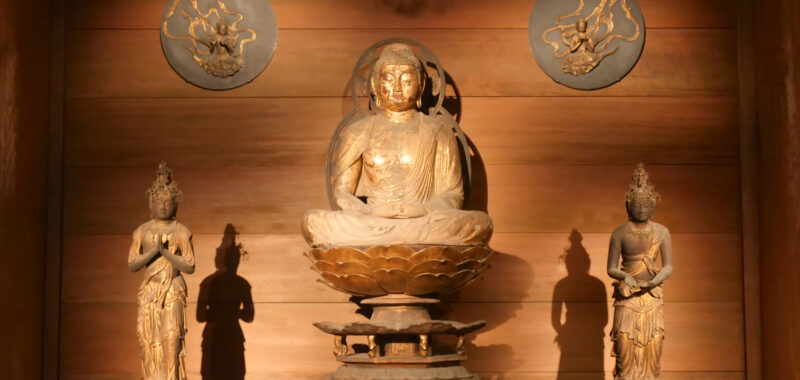Feelings of impending doom come in cycles in human history, and it’s always striking to examine this from an artistic and cultural perspective. In the 14th century in Japan, for example, mappō, or the end times, felt nigh, as Buddhist teachings would no longer be taught or received. This I learned at Anxiety and Hope in Japanese Art, an exhibition at the Metropolitan Museum of Art that comes in four rotations. The show is currently in its fourth rotation; though my visit was during the third, most of the works remain on view.
Drawing primarily from the museum’s existing collections, the show frames the works around these twin sentiments of hope and anxiety, helping to shed light on how we make sense of our own feelings of end times or apocalypse.
One of the most striking pieces is a wooden statue of Jūichimen Kannon, the Bodhisattva of Compassion with Eleven Heads. Standing six feet tall, decorated with gold leaf and metal, multiple small heads sit atop its own head, each representing a stage in enlightenment. The sculpture would have been an object of veneration in a small temple in northwest Kyoto. Its message seems clear — the path to awakening takes many lives, well beyond the one we are currently in.

Some of the more insightful works illuminate how art can help us visualize our lives to come after this one — and not always for the better. In one Taima Mandala, we see a silk scroll depicting the Buddha and a palace of attendants, dancers, and other celestial beings in the Pure Land Buddhist tradition. The rich gold tapestry shines brilliantly in the exhibition, bringing forth the many layers of details that might have brought comfort in an uncertain age, hinting that happier times may await us in the next life.
By contrast, in the Ten Kings of Hell (not currently on view), a scroll series by the Chinese artist Jin Chushi, life after death is a bureaucracy, where the recently departed must meet with different kings and their courts each week for judgment.
What I appreciate most about the show is its careful guidance into the many cosmologies of Buddhist practice. While Japanese Buddhism is often synonymous with the spare, minimalist aesthetics of Zen, the statue of Bishamonten, Guardian of the North, towering nearly seven feet high, shows a spiritual warrior in sumptuous dress atop two demons, indicating his role as a protector against evil spirits.
The more humble “The Essentials of Rebirth in the Pure Land (Ojōyōshū)” (1790) is a series of books printed from woodblock that present the types of hells one might encounter in the next life. In one evocative illustration, plumes of water sweep through to carry people away while demons appear to flay a man alive in front of an open flame.

Although this is a collections show, the framing is important. Seeing the works in person helped me understand that their charisma, as objects that might have been used in spiritual and religious practice, can be felt deeply. Where the show falters is in capturing perhaps too wide a range of time periods and eras, from medieval Japan to the colonial era to the period surrounding World War II.
While it may be useful to consider their commonalities, the show doesn’t offer enough connective tissue to fully contextualize philosophical and conceptual through lines and — perhaps more importantly — significant differences that might motivate varying and evolving Japanese world views around the themes of anxiety and hope.
All that being said, I still appreciated the range of spiritual practices in the show. I was struck by “Fei Zhangfang at Gebei Pond,” a scroll from the 16th century painted by Sesson Shūkei. If the Pure Land art proffers celestial and demonic beings, this one gives us a very human, very Daoist figure. Fei Zhangfang was a disciple of a Daoist immortal who failed at his studies.
Sesson’s rendering shows us the moment when he throws his master’s wand into a lake in frustration. Fei’s beard splays out in all directions, and the water is a murky mess of gray ink. A dragon emerges, and as legend goes, Fei would become a powerful exorcist. It’s perhaps the most honest depiction of anxiety and hope in the show — things might not work out for us in our own end times, but it’s worth trying.



Anxiety and Hope in Japanese Art continues at the Metropolitan Museum of Art (1000 Fifth Avenue, Upper East Side, Manhattan) through July 14. The exhibition was organized by Aaron Rio, associate curator of Japanese Art at The Met.

